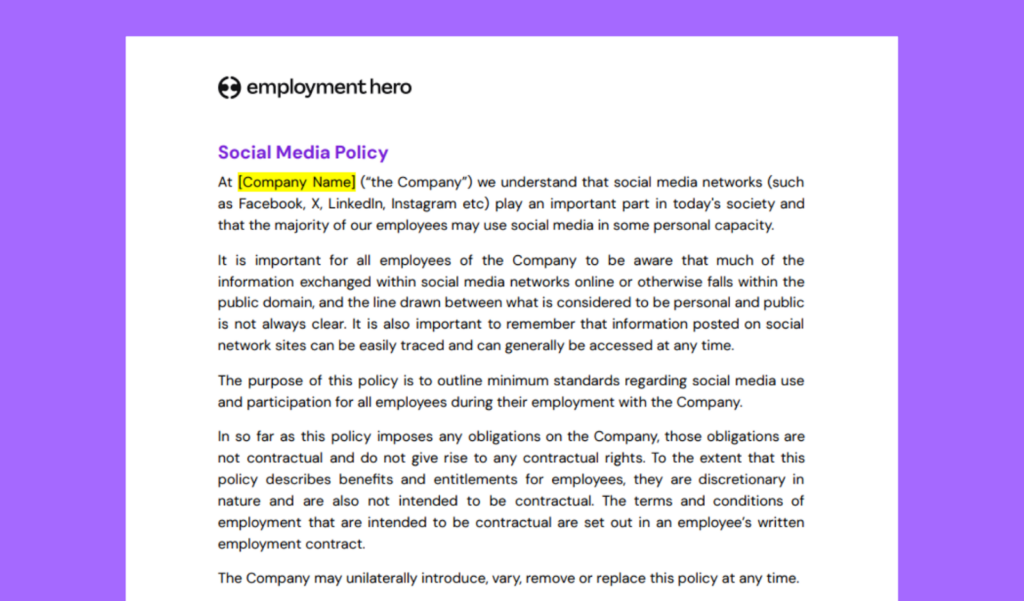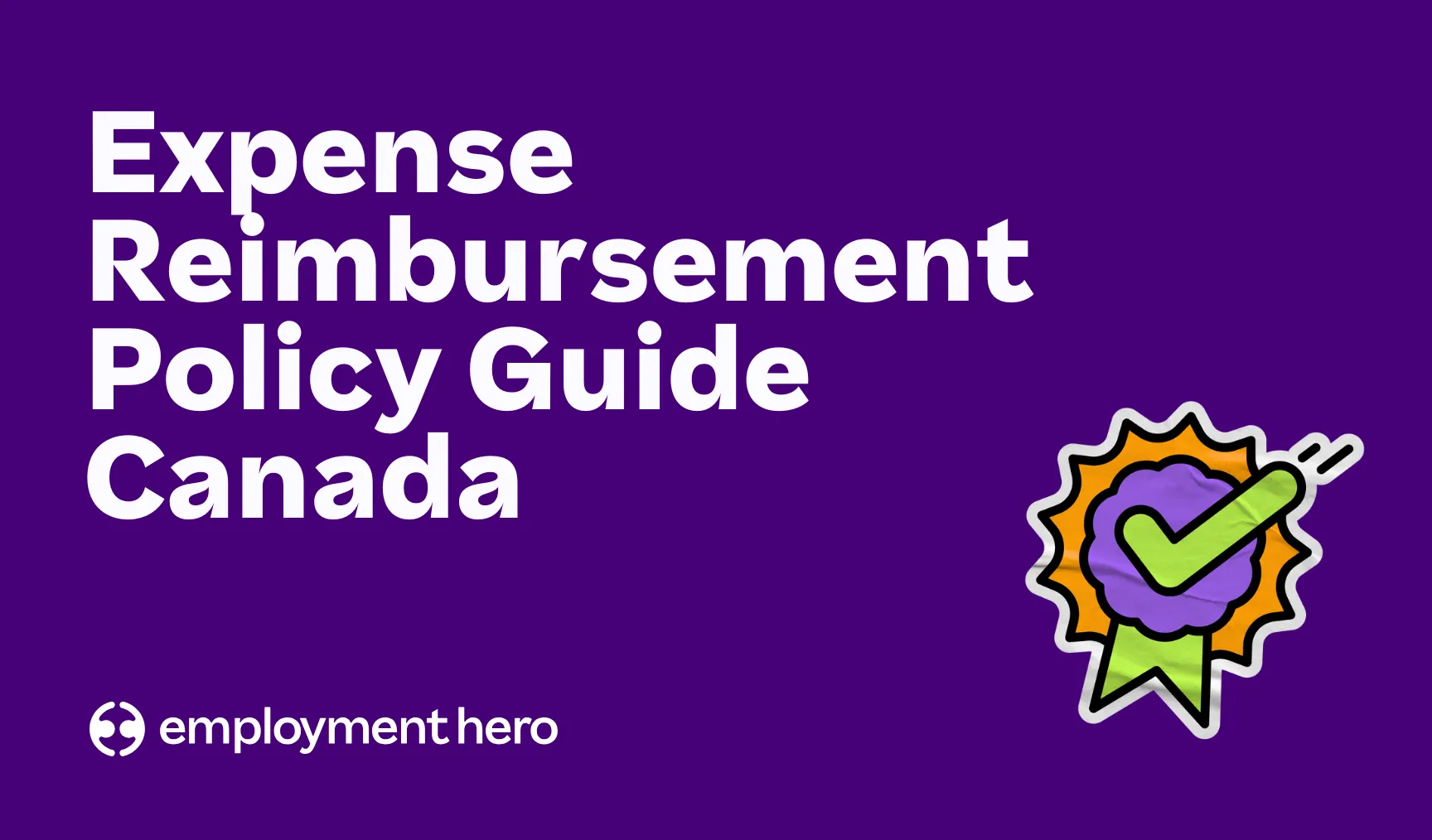Discipline policy template and guide
Published
Discipline policy template and guide
Published
A discipline policy is an essential tool for Canadian small-to-medium businesses (SMBs). When you’re running a small business, issues with employee misconduct or underperformance can have a significant impact on the future of your business. This policy template provides a clear framework for addressing employee misconduct and underperformance, helping to ensure that all disciplinary actions are handled fairly, consistently and in a way that is legally defensible.
Without a clear policy, disciplinary decisions can seem arbitrary, which can lead to confusion, low morale and even legal action. A strong policy ensures everyone in the business understands what’s expected of them, how issues will be addressed and what the potential consequences are for repeated or serious problems.
What is in this discipline policy template?
When you download our discipline policy template, you’ll receive a comprehensive, ready-to-use document that is designed to help employers create a framework for addressing employee misconduct. It outlines a progressive discipline approach, which aims to encourage employee improvement while ensuring that disciplinary measures are fair and proportionate to the seriousness of the misconduct.
This document includes key sections including,:
- Confidentiality
- Investigations
- Suspensions
- Progressive discipline stages
- Termination
- Examples of misconduct

What is a discipline policy?
A discipline policy, often referred to as a progressive discipline policy in Canada, outlines the steps an employer will take to address employee behaviour that falls below workplace standards. The goal is to encourage employee improvement through a structured, step-by-step approach. This process provides employees with an opportunity to understand the problem, what’s expected of them and the consequences of continued misconduct. It also serves as a guide for managers and business owners, helping them make consistent and fair decisions.
A comprehensive discipline policy should be a clear, ready-to-use document that defines roles and duties and outlines the disciplinary process. It should also include a confidentiality clause to protect the privacy of those involved in an investigation.
Why do businesses need a discipline policy?
Implementing a discipline policy is a crucial step to protect your business and its employees. Here’s why:
- Legal protection: A well-documented policy protects your business by ensuring that all disciplinary actions and dismissals are fair and consistent, which can help defend against claims of unfair dismissal or wrongful termination. In Canada, employers must be able to prove they had “just cause” for termination, and a clear, followed policy with documented steps is key to meeting that high threshold.
- Clear expectations: The policy sets a clear standard of behaviour and expectations for all employees in the workplace. When everyone knows the rules, there’s less room for confusion or misunderstanding.
- Consistency and fairness: It helps managers make consistent and impartial decisions. This consistency is vital for maintaining employee morale and showing that all employees are treated with dignity and respect.
- Encourages improvement: The progressive nature of the policy gives employees every opportunity to respond and improve before their employment is terminated. It’s a corrective measure, not a punitive one, aimed at rehabilitating the employee’s behaviour and performance.
Discipline policy template
Here’s a preview of the policy template you can download and customize based on your requirements:

The progressive discipline process in Canada
The progressive discipline approach is the standard for Canadian businesses, and a good policy will outline each stage. While the severity of the action depends on the seriousness of the misconduct, the process typically involves escalating steps. Employers must give an employee every opportunity to improve before moving towards termination.
1. Investigation
Before any disciplinary measures are taken, an investigation into the allegations of misconduct must be conducted. This can involve interviewing the employee and any witnesses, and reviewing relevant documents. Employees are required to cooperate fully and promptly with the investigation. In some cases, a suspension with pay may be necessary during the investigation period, but this is not a disciplinary penalty and does not imply guilt.
2. Verbal warning
For minor incidents of misconduct, the process typically begins with a verbal warning. This is a formal conversation where the manager identifies the issue, explains the expected conduct and records the details in the employee’s personnel file.
3. Written warning
A written warning is usually issued if the misconduct continues after a verbal warning or if the initial incident is more serious. This formal letter details the misconduct, outlines expectations for improvement and warns the employee about the consequences of further misconduct, including the possibility of suspension or termination. A copy of this letter should be placed in the employee’s file.
4. Suspension
For gross misconduct or repeated offences, a suspension may be an appropriate step. The suspension can be unpaid and for a period of time appropriate to the circumstances. A suspension letter is provided to the employee, detailing the misconduct and the conditions for their return to work. It is important to note that a suspension is not a termination and that employees who are suspended should not visit the employer’s premises or contact clients or coworkers unless authorized.
5. Final written warning
A final written warning is used when misconduct persists despite earlier warnings and/or suspensions, or for a single incident of gross misconduct that is serious enough to warrant it. This letter explains that any further misconduct will result in termination for just cause. A final written warning may also be combined with a disciplinary suspension.
6. Termination
Termination for just cause is the final step in the progressive discipline process and is reserved for situations where repeated misconduct has occurred despite previous interventions, or for a single incident of gross misconduct that is incompatible with continued employment. A termination letter should be provided to the employee detailing the misconduct as the basis for termination.
Best practices for developing a discipline policy
A strong discipline policy is more than just a template; it’s a living document that guides your business’s culture and protects its legal standing. Here are some best practices for creating and implementing one:
- Communicate clearly: Ensure employees clearly understand what’s expected of them and that a policy exists. The policy should be easily accessible and all employees should receive training on it.
- Document everything: Keeping detailed records is essential. Document all discussions, warnings and actions taken, as this creates a clear audit trail that shows your business gave the employee a fair chance to improve before dismissal.
- Be consistent: Apply the policy fairly and consistently to all employees. Decisions should not feel arbitrary or inconsistent.
- Procedural fairness: Throughout the process, an employee must be given an opportunity to respond to allegations and, in meetings where dismissal is discussed, be allowed to have a support person with them. They should also receive advance written notice of the meeting’s purpose.
The importance of documentation
Documentation is the bedrock of a legally defensible discipline policy in Canada. It proves that you followed a fair and consistent process. A clear audit trail shows that your business gave the employee a fair chance to address concerns and that termination was the last resort. This is particularly important for small businesses, which are still required to be cautious and adhere to a strict employee termination procedure.
When to use the discipline policy
This policy can be used in different scenarios, whether you’re dealing with poor performance or someone who behaves poorly at work. It’s your guide for providing corrective action and performance management. You must give employees every opportunity to respond and improve before you dismiss them.
In cases of summary dismissal, where an employee is guilty of serious misconduct such as theft, fraud, violence or serious breaches of occupational health and safety, you can dismiss the employee without a notice period. However, even in these cases, you must still follow a robust disciplinary process.
Download our discipline policy template
Ready to build your discipline policy? Download our template using the form on the right. Need more guidance on policy creation? Our HR Advisory team supports SMBs with compliance checks, expert workplace consulting and with an extensive resource library in our platform. Talk to our business specialists to find out more.
The information in this template is current as at 1 September 2025, and has been prepared by Employment Hero Pty Ltd (ABN 11 160 047 709) and its related bodies corporate (Employment Hero). The views expressed in this template are general information only, are provided in good faith to assist employers and their employees, and should not be relied on as professional advice. The Information is based on data supplied by third parties. While such data is believed to be accurate, it has not been independently verified and no warranties are given that it is complete, accurate, up to date or fit for the purpose for which it is required. Employment Hero does not accept responsibility for any inaccuracy in such data and is not liable for any loss or damages arising either directly or indirectly as a result of reliance on, use of or inability to use any information provided in this template. You should undertake your own research and to seek professional advice before making any decisions or relying on the information in this template.
Frequently asked questions about discipline policies
A discipline policy, often referred to as a progressive discipline policy in Canada, is a vital document outlining the steps an employer takes to address employee behaviour that falls below workplace standards. It’s crucial for Canadian small-to-medium businesses (SMBs) because it provides a clear framework for addressing misconduct and underperformance fairly and consistently, offering legal protection against claims of unfair dismissal, setting clear behavioural expectations, and ultimately encouraging employee improvement through a structured, step-by-step approach.
The progressive discipline process in Canada typically involves escalating steps, starting with a thorough investigation into the allegations. This is followed by a verbal warning for minor incidents, then a written warning if misconduct continues or is more serious. For gross misconduct or repeated offences, a suspension may be issued, leading to a final written warning if issues persist. Termination for just cause is reserved as the final step when all previous interventions have failed or for single incidents of severe gross misconduct.
Clear communication and consistent application of a discipline policy are paramount for Canadian businesses because they foster a transparent and fair workplace environment. When employees clearly understand behavioural expectations and the consequences of not meeting them, it reduces confusion, boosts morale and ensures all individuals are treated equitably. Consistent application across all employees helps to avoid perceptions of bias or arbitrary decision-making, which is crucial for defending against potential legal challenges like wrongful dismissal claims. Ultimately, a well-communicated and consistently applied policy builds trust, encourages positive conduct and protects the business’s reputation and legal standing.
In Canada, “just cause” termination refers to an employer’s right to dismiss an employee without notice or severance pay due to serious misconduct or a fundamental breach of the employment contract. This is a high legal threshold for employers to meet, requiring compelling evidence that the employee’s actions were so egregious or that they repeatedly failed to meet reasonable expectations despite progressive discipline, making continued employment untenable. Employers must demonstrate they conducted a thorough investigation, applied their discipline policy consistently and that the misconduct was severe enough to warrant immediate termination.
Register for the template
Related Resources
-
 Read more: Expense Reimbursement Policy Guide Canada
Read more: Expense Reimbursement Policy Guide CanadaExpense Reimbursement Policy Guide Canada
Download a free expense reimbursement policy guide for Canadian businesses. Learn how to create a clear, compliant policy for managing…
-
 Read more: The professional development plan Canada’s top teams use
Read more: The professional development plan Canada’s top teams useThe professional development plan Canada’s top teams use
Download a free professional development plan template for Canadian businesses. Help employees set goals, track progress and achieve career growth.
-
 Read more: HR Managers: Don’t just survive the festive season, master it
Read more: HR Managers: Don’t just survive the festive season, master itHR Managers: Don’t just survive the festive season, master it
Make year-end easier: manage time-off, payroll, parties and shutdowns with confidence. Get practical tips for Canadian SMBs. Download the free…


















